Measurement-Driven Iterated Correction GM-PHD Filter for Passive Tracking With Hardware-in-the-Loop Simulation
Abstract
Considering the characteristics of Multi Aircraft Attack and Defense (MAVAD), the problem of multisensor multitarget passive tracking is researched in this article. Firstly, to solve the problem posed by incomplete or unknown knowledge about the intensity of the target’s newborns, a practical measurement–driven method of adaptive generating newborn intensity function is adopted. Then, a method named measurement–driven iterated correction Gaussian–mixture probability hypothesis density (MD-IC-GM-PHD) filter is proposed to overcome the difficulties of the observability of targets in passive tracking. Based on the above methods, a rational and efficient approach to trajectory management is presented to complete the task of recording the historical information about target states. Finally, a hardware-in-the-loop (HIL) simulation system is implemented to verify the validity of the designed multiple target tracking (MTT) algorithms.
1. Introduction
According to the detection information acquired by the sensors, MTT [1, 2] refers to the joint estimation of the number of targets in the detection area, the trajectories of the individual targets, and other characterization attributes of interest. In the scenario of MAVAD, MTT technology plays a vital role in providing information for aircraft guidance and control systems.
Due to the excellent invisibility of passive sensors, such as infrared and external radiation source radar (ERSR), passive tracking [3] become a very advantageous technique for antielectronic countermeasures, antiacoustic countermeasures, antireconnaissance, and the implementation of surprise attacks on targets. Since passive sensors can only obtain angle information from targets, it can be called bearing-only tracking. Aiming at the nonlinear problem of bearing-only tracking, extended Kalman filter (EKF), unscented Kalman filters (UKF), Gaussian sum filter, and particle filter (PF) have been utilized in many practical applications. Unfortunately, these methods cannot directly achieve MTT in MAVAD [4–6].
After years of development, the research on MTT technology has made huge progress. Based on the random finite set (RFS) theory, a series of tracking filters were proposed and researched, such as the probability hypothesis density (PHD) filter [7–9], cardinality probability hypothesis density (CPHD) filter [10], cardinality–balanced multitarget multi-Bernoulli filter (CBMeMBer) filter [11, 12]. Besides, RFS filters containing label information, like the generalized labeled multi-Bernoulli (GLMB) filter [13] and labeled multi-Bernoulli (LMB) filter [14], were derived to obtain trajectory information about targets.
To get rid of reliance on the priori intensity of the newborn, the measurement–driven target birth method is first proposed and applied on PHD/CPHD filters [15]. Then, a measurement set partition mechanism was proposed to optimize the target birth process in a high-density clutter scenario [16]. To accurately describe the state distribution of newborn targets, Reference [17] used a discrete kernel estimator and exponential weighted moving average scheme. In the field of extended target tracking, Reference [18] approximated the intensity of the newborn and potential target to β-γ-Gaussian inverse Wishart (BGGIW) mixed form. In radar long-term continuous monitoring scenarios, Reference [19] optimized the division of the measurement set and the estimation of the newborn target state distribution.
With the increasing complexity of the battlefield environment, single-sensor multiple–target tracking systems cannot satisfy the requirements of tracking accuracy and reliability anymore. Aiming at this fact, research on multiple sensor fusion systems for multiple target tracking has attracted great interest, and a series of multisensor fusion approaches appeared. Several typical filters such as the iterated corrector PHD (IC-PHD) filter, product multisensor PHD (PM-PHD), and general multisensor PHD (general PHD) were proposed by Mahler [20–22]. Considering both algorithmic performance and computational realizability, a parallel combinatorial multisensor Bernoulli–filtering algorithm was put forward by Nannuru, which used the greedy algorithm to segment the measurements and combine them with parallel filtering [22, 23]. However, the computational complexity is linearly related to the growth of the number of sensors, which causes great difficulties to practical application. In recent years, the fusion of average consensus has attracted widespread attention, including arithmetic average (AA) fusion and geometric average (GA) fusion [24, 25]. Nevertheless, both belong to the suboptimal fusion method, and the estimation accuracy may not be satisfying when the number of sensors is limited.
The trajectory management is responsible for correlating the discrete state of the target to form a complete and continuous trajectory of the target. The problem of missed detection and false alarm in MTT poses certain difficulties in accurately generating trajectories. By integrating the track management into multiple targets Bayes filter frame, labeled RFS was proposed to realize the synchronization of filtering iteration and track management [13, 26]. However, the computational complexity of these filters was too high to be applied in real engineering.
In order to reduce costs, the HIL simulation system needs to precede experimentation in the product development process [27, 28]. The risk of discovering errors in the final stage of field testing can be reduced. And it makes up for the shortcomings of the traditional software simulation that cannot accurately reproduce the actual operating conditions of complex systems; thus, HIL has been widely used in in many fields. In the field of aviation and aerospace, HIL simulation is widely implemented. Based on the data of the United States on the Patriot and Stinger missiles, HIL simulation technology has been chosen for the development of missile weapons. Its test time can be reduced by 30%–40%, and the number of test missiles can be reduced by 43.6% [29]. Some authors verified their attitude dynamics model and attitude kinematics model of satellite attitude control system with HIL simulation [30, 31]. Moreover, a multiplatform HIL was exploited to emulate the multiagent system and the communication between the UAVs, thereby reducing the risk of swarm failure [32]. Even in automotive electrification, some research about control strategy was implemented on the HIL system [33]. Inspired by them, MTT technology in the MAVAD scenario also needs to be validated by the HIL system.
- 1.
With the adaptive measurement–driven method of generating a newborn intensity function, the problem of observability of the target is solved by using multiple sensors IC-GM-PHD filter.
- 2.
Label–based trajectory management is proposed to overcome the difficulties of the historical association of target trajectory.
- 3.
The scene reconstruction method is introduced. HIL simulation is built to verify the feasibility of the proposed algorithm.
2. Preliminary Information
2.1. RFSs
In the multitarget scenario, the number of targets and their trajectories vary with time due to targets appearing and disappearing. Thus, target’s state can be modeled as a finite set of single-target state, and the MTT problem is formulated as a dynamic multitarget state estimation problem.
Xk is the multitarget state set at moment k, Sk|k−1(ζ) is the spawn target sets from moment k − 1, Bk|k−1(ζ) is the RFS of survival targets, while Γk is the newborn target set.
2.2. GM-PHD Filters
- 1.
The kinematic and observation model of each target can be described by the linear Gaussian dynamical model.
- 2.
Each target survival probability and probability of being detected are independent of the target state as
- 3.
The intensity of newborn and spawning target RFS can be represented as Gaussian mixture form as
- I.
Prediction
- II.
Update
- III.
Pruning and merging
- IV.
State extraction
The most commonly used method is to select the means of the GCs whose weights are greater than a preset threshold, as target states. According to engineering experience, the threshold is usually set to be 0.5.
2.3. Single Target Filter for Bearing-Only Measurement
Substituting Equations (19) and (20) into updating equations in an EKF, it can be able to design a single sensor filter easily.
3. Measurement–Driven Adaptive Newborn Density
3.1. Measurement–Driven Generation of Newborn GCs
According to the analysis of traditional GM-PHD trackers, if the Gaussian mixing form of the intensity function of the newborn target is given priority, the tracking performance will heavily rely on the selection of the GC of the intensity function of the “newborn.” On the contrary, the weight amplification process slows down during the measurement updating process, and it takes longer to cross the state extraction boundaries and be confirmed to be extracted. In the extreme case, the weights are progressively reduced and thus pruned, as shown in Figure 1.
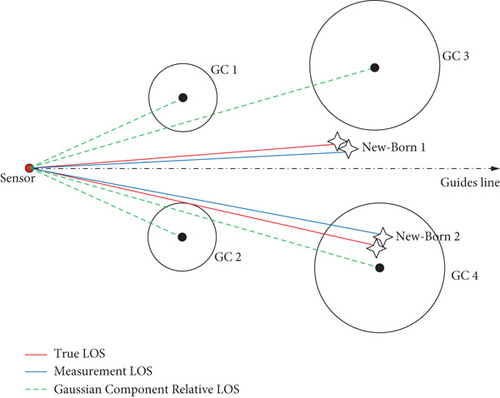
In other words, the selected newborn GCs adjacent to the truth are more likely to cross the state extraction boundaries with measurement updates. The accuracy about the target state of priority given by experience is restrictive extremely. In view of the above experience, the GM-PHD multitarget tracking driven by current measurements is proposed, which can generate the Gaussian mixture of intensity functions at the “birth point”. The specific forms are as follows:
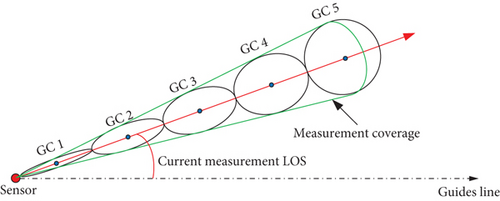
In the above equation, R is the detection distance with the maximum Rmax and minimum Rmin. NR is the number of segments of the radial detection range. and are the measurement of LOS. δqε and δqβ denote the standard deviations of the measurement model. is the position of each sensor, generated by navigation module. Some constant values , , PVel, and are provided as a priority according to the combat performance of missiles. Through Equation (21), and can be calculated with the above parameters.
Due to the utilization of current measurement, the method is able to generate newborn intensity which has a great approximation to the probability density of a “real” newborn target. Theoretically, the performance of tracking has a positive correlation with the number of segments in the radial detection range of the detector. Thus, the denser the GCs are distributed in the radial direction, the higher the probability of gaining GCs which approach to the “real” newborn target can be obtained.
3.2. Measurement–Driven IC-GM-PHD
The iterative form of the PHD filter is an approximate multisensor PHD. During the update process, the measurement information received from all sensors cannot be used at the same time, so the measurement information from each sensor needs to be filtered in a certain order. As shown in Figure 3, IC-PHD includes one-step prediction and multiple PHD update processes.

To overcome the problem of observability of the target in the scenario of bearing-only detection, the principle of IC-PHD is reasonable. By updating the updated intensity function of the previous sensor, the weights of GCs belonging to the true target will increase so as to be extracted states.
The whole workflows of MD-IC-GM-PHD are as Table 1.
|
4. Label–Based Trajectory Management Method
Multitarget trajectory management algorithms can realize the historical association and vertical classification of the target state information in the time sequence. Generally, the spacing of missiles in the group is not too far. After release, missiles may overlap and separate in the sensor’s field of view (FoV). It is a huge challenge to implement the correct association of measurements and trajectories before and after rejoining and separation. To solve the problem of historical association of target trajectory, a label–based trajectory management method is presented.
On the basis of GM-PHD, GCs are labeled specifically using the following label set. τj is the label of the jth GCs. Each component in the prediction intensity function yields (1 + |Zk|) GCs after measurement updating. As shown in Figure 4, the updating GCs own the same label as the prediction one.
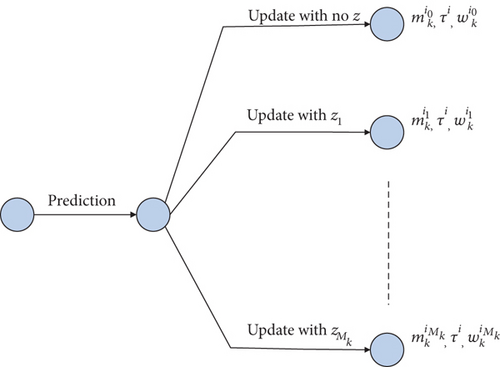
Besides, the pruning and merging processes need to be modified as Table 2.
|
From the foregoing, the new labels only appear during initialization and the occurrence of the newborn GCs. Progressively, each initialized Gaussian term and each “birth point” Gaussian term acts as a root node and evolves into a tree structure with the same label (consistent with the label of the root node). As shown in Figure 5, each node of the tree structure contains information about the weights, mean, and variance of each Gaussian term at the corresponding moment. Thus, each branch of each tree structure with a specific label may represent the trajectory of a target in the FoV (historical evolutionary information of the state).
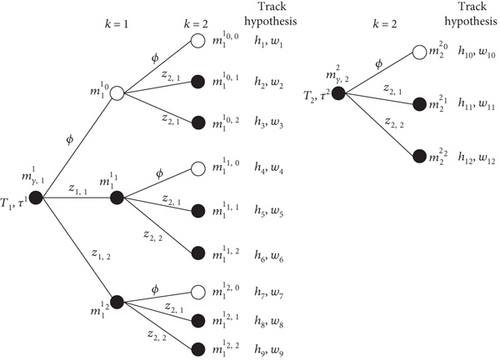
Here, nconformed and nmissed are configured to record the number of moments when the GCs on each branch carry a weight more and less than 0.5 consecutively. indicates the boundary of the conformed initial trajectory, while indicates the boundary of the conformed terminal trajectory. The branch is recognized as a track in the FoV if , and being termination if . During the period when , the prediction of the Gaussian term of the branch node at the previous moment can be retained as a “pseudoupdated” Gaussian term at the branch node at the current moment.
5. Hardware-in-the-Loop System Simulation
- 1.
The target simulation controller displays the trajectory of the target in the FoVs on the target simulation device via Unity3d software. Each target is represented by a small circle in the FoV as shown in Figure 8. The target simulation controller solves for the FoV angle in each FoV based on the offline generated target positions. And the design sketch is shown in Figure 7.
- 2.
The task of the target detection system is capturing points on the screen by industrial cameras and acquiring angle information of targets through solving images. Then, each DSP executes a target-tracking algorithm regarding the measurement provided by the angle-solving module and sends the result of the algorithm to the next DSP in order to implement sequential operation. Among them, the first DSP served as the fusion center by collecting all measurement sets from other DSPs and executing new birth intensity generation.
- 3.
The host computer gains the trajectory information produced by the MTT algorithm, plots the trajectory dynamically, and displays the performance of the algorithm.
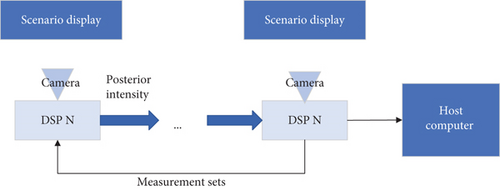
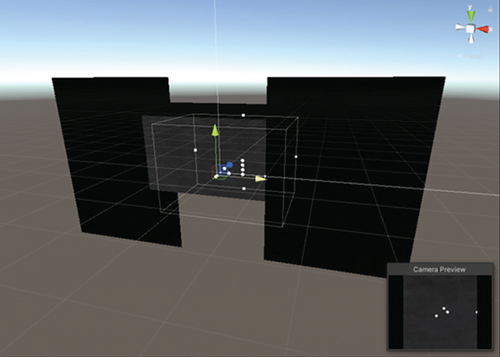
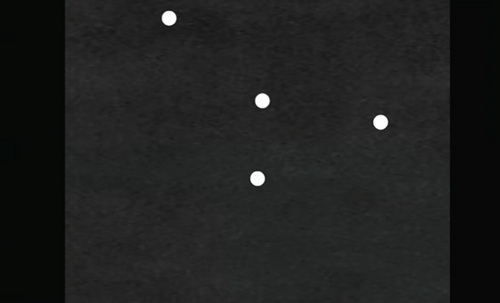
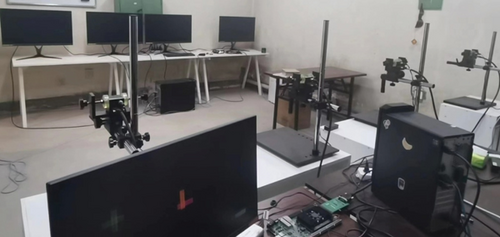
Our hardware configuration is shown in Table 3:
| Image display |
|
| Image capture and MTT |
|
| MVC1381SAM-CL60-S00V0003 camera |
- 1.
Set four targets as enemy missiles and four cameras with DSPs to simulate our own side aircrafts. The initial distance between targets and aircrafts is 200 km, and the approach velocities are set to be 5 km/s. Target motion initial positions and velocities are set in Table 4:
| Target | Kinematic parameters |
|---|---|
| 1 | |
| 2 | |
| 3 | |
| 4 |
- 2.
Parameters of the IC-GM-PHD filter are configured according to Table 6.
| Sensor | Kinematic parameters |
|---|---|
| 1 | x = −3700000 m, y = −42000 m, z = 6600000 m |
| 2 | x = −3700000 m, y = −47000 m, z = 6600000 m |
| 3 | x = −3700000 m, y = −51000 m, z = 6600000 m |
| 4 | x = −3700000 m, y = −47000 m, z = 6700000 m |
|
|
- 3.
The detection area is assumed that no clutter appears in the FoV, and only measurements generated by targets can be collected by cameras. Then, the performance of the tracking algorithm relies heavily on the qualities of detection by cameras. The angle tolerance range of camera detection is calibrated and controlled to be within average 0.5mrad. Restricted by physical conditions and the problem of sensor calibration, consistency of detection accuracy is not guaranteed.
represents the estimation of jth state components, and is the real value of the state at moment k. In a Cartesian coordinate system 3D tracking scenario, target position and velocity information consist of three dimensions.
To realize communications synchronization, target detection, and tracking, the average computational times for a simulation loop period are within 15 ms.
The result of trajectory tracking is displayed dynamically on the host computer during every algorithm period as shown in Figure 10. The labels of trajectory are generated randomly leading to different values in legend. For example, Track 32 corresponds to Target 1, and Track 48 corresponds to Target 2.

Figure 10 also shows the engagement scenario between the tracker and targets, the trackers execute ground attack instructions with PN guidance law, and the targets represent interceptors with a one-on-one interception strategy. The thick lines represent the truth trajectories of targets while the asterisk lines denote their estimation trajectories. Moreover, the motion paths of observers are displayed using thin lines in Figure 9. The trajectories of the targets and sensors along X-Y-Z axis are shown, respectively, in Figures 11(a), 11(b), and 11(c). As can be seen from the figure above, the asterisk lines almost cover the thick lines. This implies that the estimation tracks are very close to the truth. In order to further demonstrate the filter convergence process, Figure 12 takes the tracking path of Target 1 as an example.
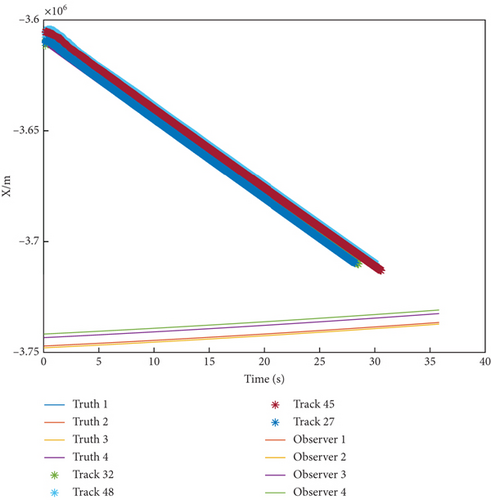
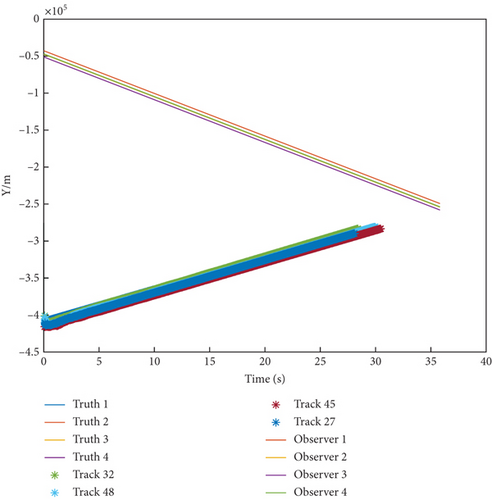
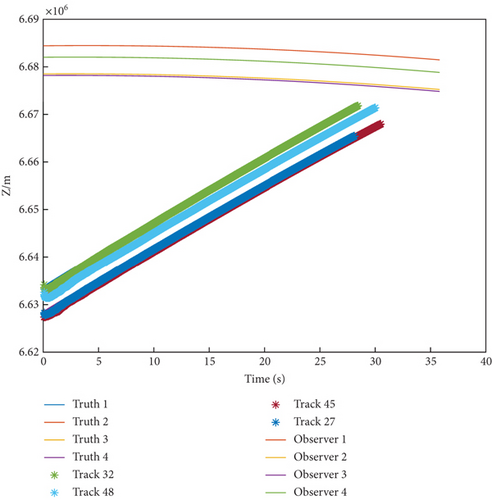
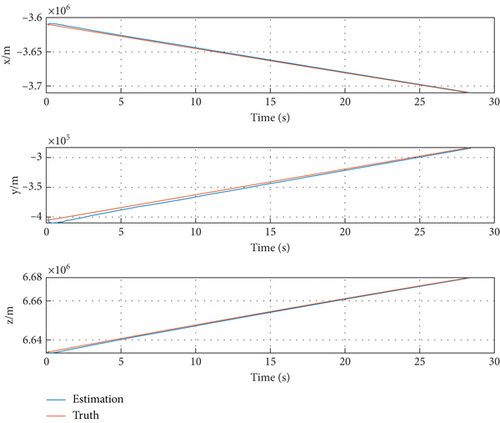
Figures 13, 14, and 15 show that MD-IC-GM-PHD is able to complete the task of target tracking in the MAVAD scenario, and tracking accuracy is within an acceptable range. The bias of state estimation mainly results from the inaccuracies of the target detection module, composed of quantization error and angular resolution error.
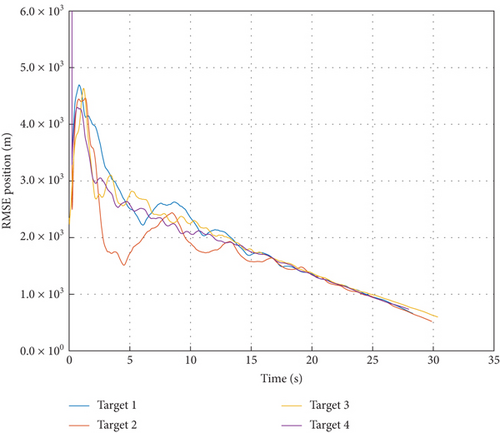
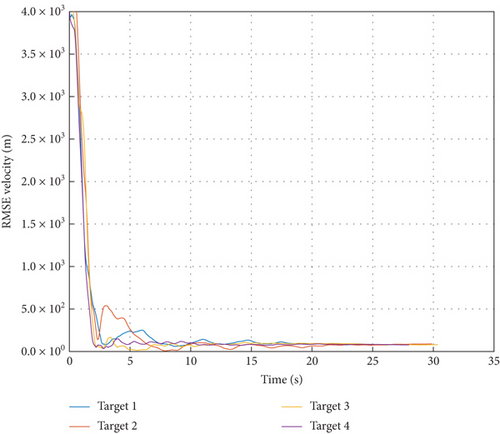
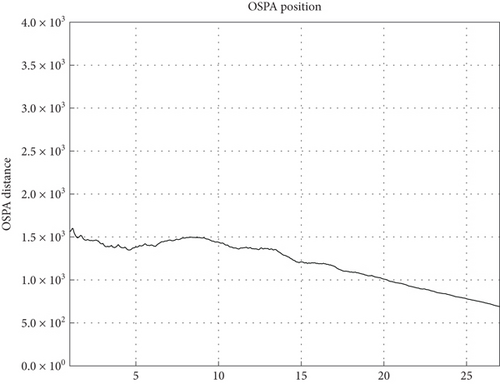
In order to conduct comparative experiments, the preconfigured newborn intensity is set in Table 7.
It is validated that the tracking filter diverges by presetting newborn intensity under the abovementioned simulation scenario.
A different number of sensors using the mentioned measurement-driven method is adopted to perform the MTT task. OSPA distance is calculated after four groups of simulation, and the result is presented in Figure 16:
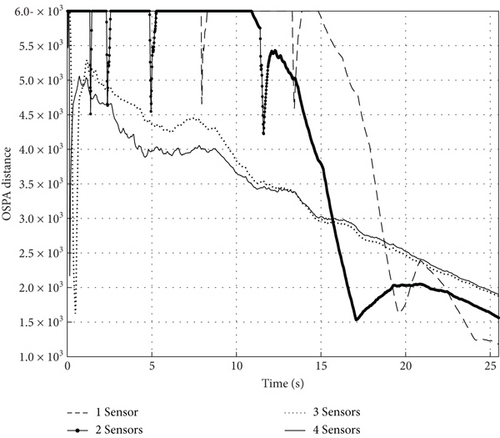
As shown in Figure 16, the convergence speed of the tracking filter positively correlated with the amount of sensors executing the MD algorithm. The reason for this is that the generation of more newborn point GCs means a higher probability of approaching the true trajectory. The simulation result is reasonable according to the analysis in Section 3.1.
6. Conclusion
In this paper, the problem of tracking multiple maneuvering targets with bearing-only measurement is considered. Considering little priori information about newborn targets in practical applications, a newborn intensity function is adaptively generated using a measurement-driven method. Compared with the traditional preparameterized approach, MD-IC-GM-PHD possesses better robustness and eliminates the need to set the initial value. Furthermore, label–based trajectory management is applied and combined with the MD-IC-GM-PHD algorithm. The convergence and effectiveness of the proposed MD-IC-GM-PHD are proved in simulation. To validate the presented algorithm, a hardware-in-the-loop simulation system was built. The design of this system highly recreates the scenario of multiaircraft countermeasures and greatly reduces the cost of experimentation. Additionally, this platform provides convenience for further research on the MTT problem.
Conflicts of Interest
The authors declare no conflicts of interest.
Author Contributions
Runle Du and Jizhe Wang contributed equally to this work.
Funding
No funds were received.
Open Research
Data Availability Statement
The data used to support the findings of this study are available from the corresponding author upon request.




